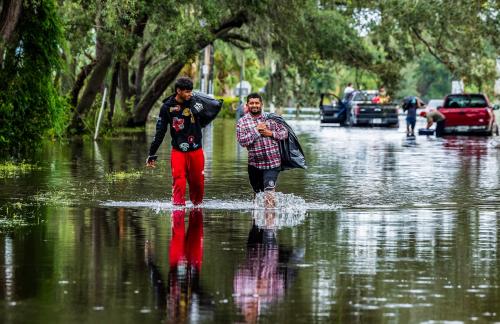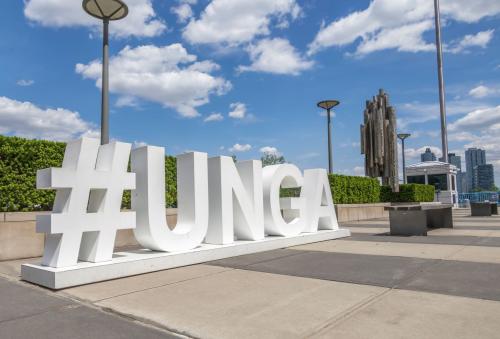Internal displacement, i.e. the coerced or otherwise involuntary movement of persons away from their homes to other locations inside their own country, is among the world’s biggest but probably least known contemporary problems. Around 25 million persons worldwide are estimated to be displaced by conflict, a number two and a half times that of refugees, i.e. persons who have fled abroad. The number of those who had to flee natural disasters is volatile but at times reaches or surpasses the 25 million mark. For instance, as we meet here, hundreds of thousands of persons are being or threatened to be displaced by the current floods in the Southern part of Africa. Last week, five days’ torrential rain in two districts of Sri Lanka (Ampara and Batticaloa) which I visited just four weeks ago, has led to over 28,000 people fleeing their homes. As is evidenced by Hurricane Katrina, the California wildfires or the floods in the UK’s midlands of last summer, not only the poor countries of the South but also Europe and North-America have their share of persons displaced by natural disasters.
My mandate as Representative of the UN Secretary General on the Human Rights of Internally Displaced Persons covers all types of internal displacement, including persons displaced by natural disasters. But, some might ask, what have such disasters to do with human rights?
While it is correct that those displaced by floods, earth-quakes, tsunamis and the like are primarily in need of humanitarian assistance, experience from natural disasters all over the world teaches us that there is a serious risk of human rights violations when the displaced cannot return to their homes or find new ones after some weeks or months. In the context of natural disasters, discrimination and violations of economic, social and cultural rights can become more entrenched the longer displacement lasts. These violations are in most cases not consciously planned and instigated but result from a lack of inappropriate policies. They could, therefore, be easily avoided if the relevant human rights guarantees were taken into account from the outset.
Take Hurricane Katrina: The UN Human Rights Committee, a body of independent experts entrusted with the task of monitoring the implementation of the International Covenant on Civil and Political Rights, when examining the report submitted to it by the USA, expressed its concerns “about information that the poor, and in particular African-Americans, were disadvantaged by the rescue and evacuation plans implemented when Hurricane Katrina hit the United States, and continue to be disadvantaged under the reconstruction plans” and recommended to the US to:
“review its practices and policies to ensure the full implementation of its obligation to protect life and of the prohibition of discrimination, whether direct or indirect, as well as of the United Nations Guiding Principles on Internal Displacement, in matters related to disaster prevention and preparedness, emergency assistance and relief measures. In the aftermath of Hurricane Katrina, the State party should increase its efforts to ensure that the rights of the poor, and in particular African-Americans, are fully taken into consideration in the reconstruction plans with regard to access to housing, education and healthcare” (CCPR/C/USA/CO/3/Rev.1, para. 26).
My visit here is not an official mission focusing on fact-finding. Rather I have come here on the invitation of the Brookings-Bern Project on Internal Displacement and Advocates for Environmental Human Rights from New Orleans to learn from those directly affected, authorities at the different levels and the communities concerned about the challenges in the aftermath of a disaster as unprecedented as that caused by hurricane Katrina. I will also participate in workshops with officials and affected communities in New Orleans on how to find durable solutions for victims of displacement. This is the first of a series of working visits planned for this year which will take me also to Central America, Southern Africa and hopefully Southeast Asia. All these visits are aimed at better understanding how a human rights framework would help to better deal with the particular challenges caused by natural disasters and how human rights standards can provide principled guidance to finding solutions for those in displacement.
In doing this, I do not come with empty hands. The UN Guiding Principles on Internal Displacement that were submitted to the UN in 1998 provide, as has been unanimously recognized by the 2005 World Summit “an important international framework for the protection of internally displaced persons.” They reflect and are based upon binding international human rights and spell out the guarantees protecting displaced persons against displacement, during displacement and regarding return (or integration in another part of the country). The “Operational Guidelines on Human Rights in Situations of Natural Disasters” which I developed with the support of the Brookings-Bern Project have been adopted by the humanitarian agencies of the UN as a tool for ensuring that disaster relief and reconstruction efforts are conducted within a framework that protects and furthers human rights. Brookings will publish in a few weeks time a Field Manual facilitating the use of the Operational Guidelines. Finally, we have developed in collaboration with Georgetown University a “Framework for Durable Solutions” that sets out the process as well as the material conditions necessary to end displacement.
In the context of finding durable solutions for persons displaced by natural disasters, the following key principles are of particular importance:
- The right of the displaced to freely choose whether they want to return, integrate at the location where they were displaced to, or start a new life in another part of the country. Of course, a real choice is only possible once return becomes possible;
- The right of the displaced to be informed and consulted about their future and the options available;
- The primary responsibility of authorities to create conditions that allow for return in dignity, i.e. conditions allowing returnees to have access to adequate housing, an to services such as health and education, and to gainful employment or other means of livelihoods.
It is my hope that these standards and tools that have been and are being used in other parts of the world, will help to protect the victims of natural disasters and their human rights in this country, too.
Thank you.
The Brookings Institution is committed to quality, independence, and impact.
We are supported by a diverse array of funders. In line with our values and policies, each Brookings publication represents the sole views of its author(s).



Commentary
A Human Rights Perspective for Major Natural Disasters
January 14, 2008